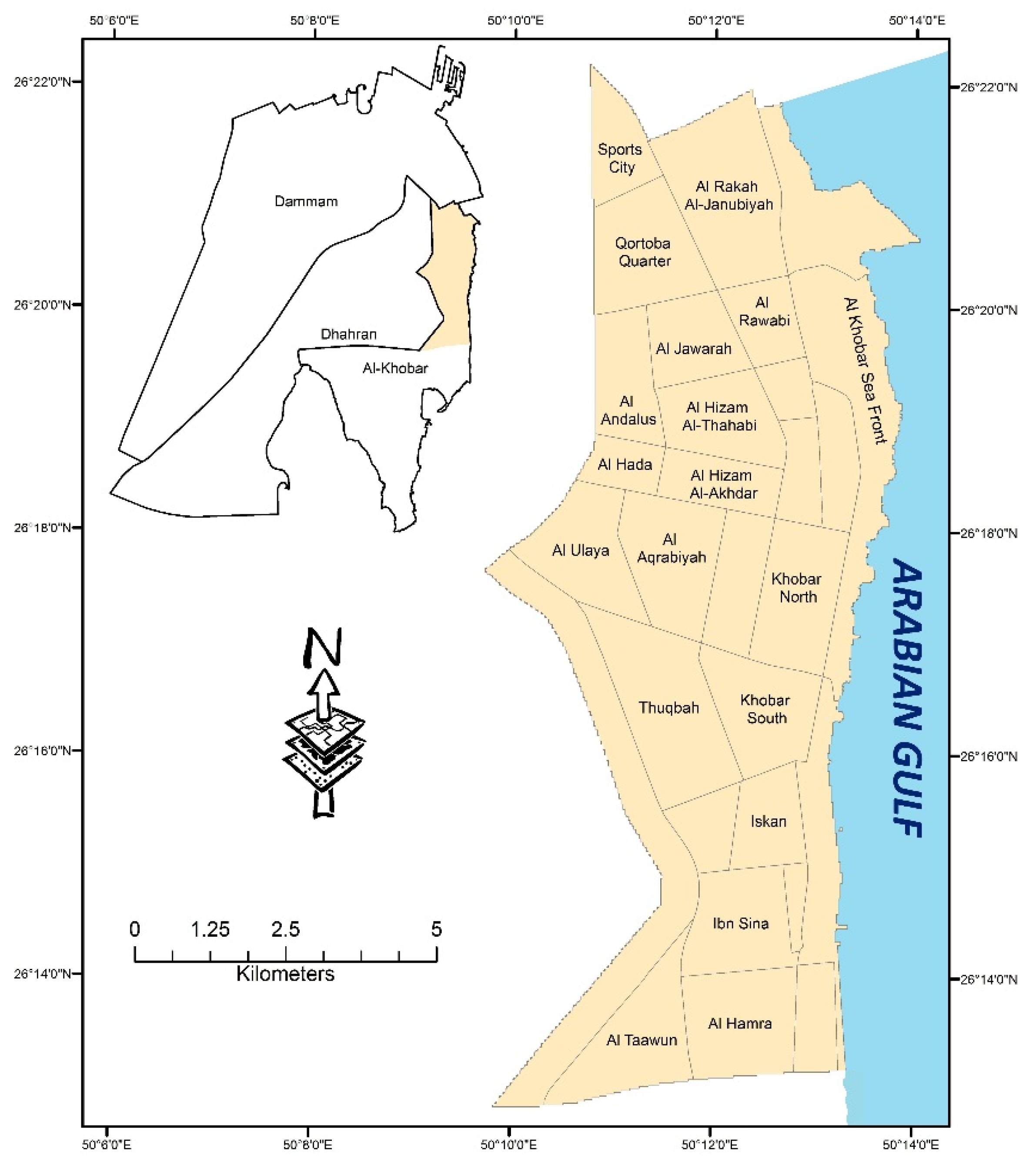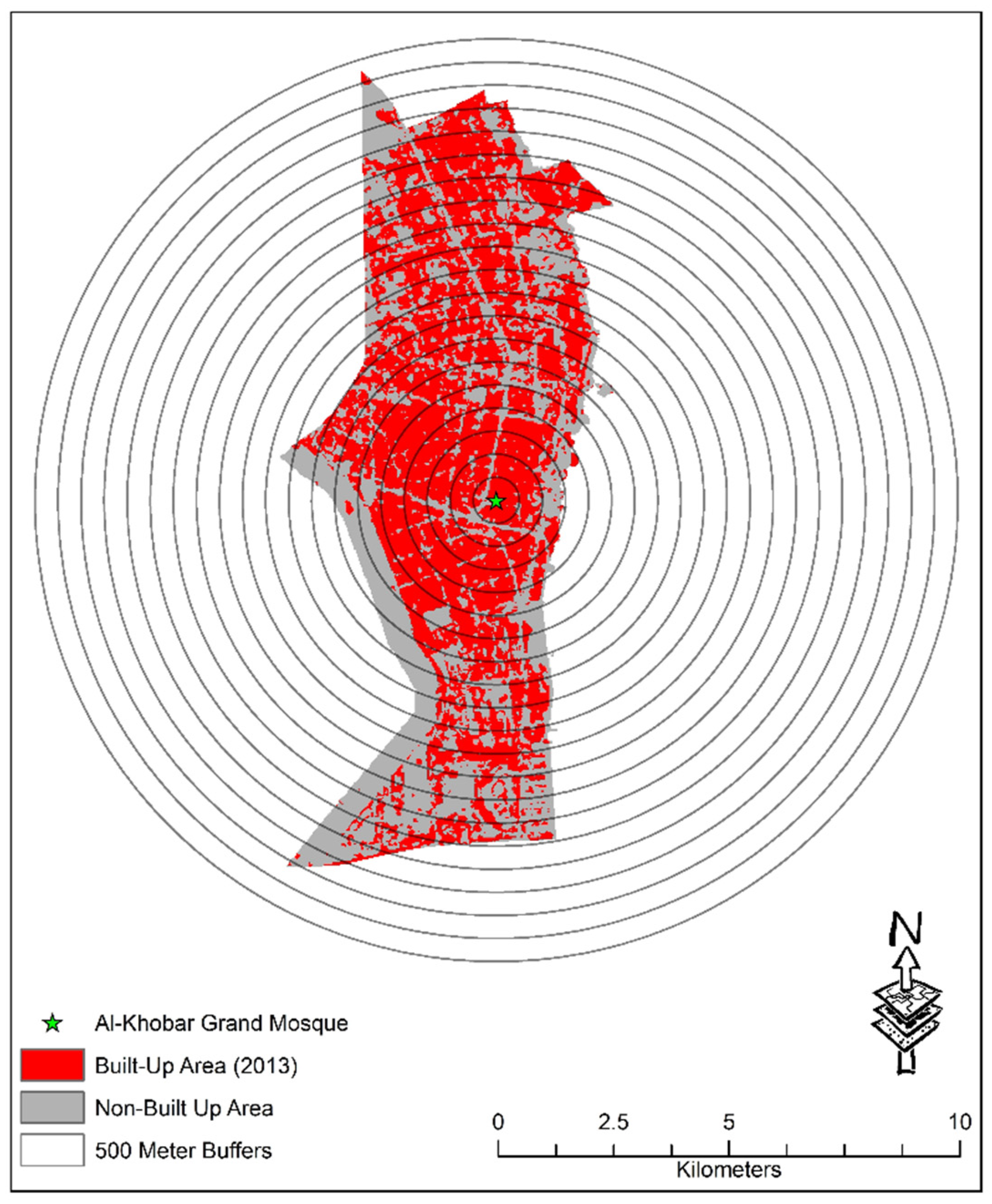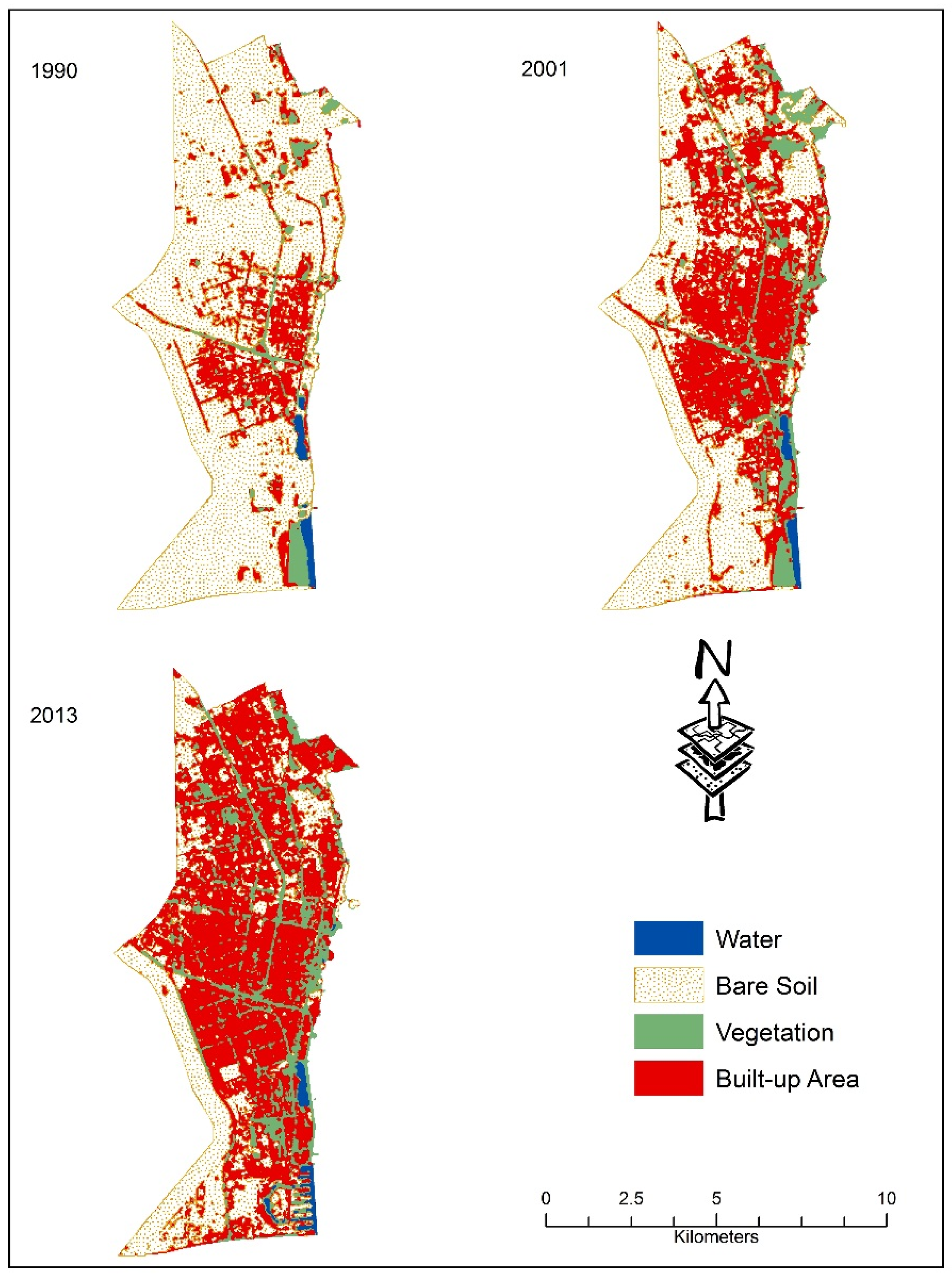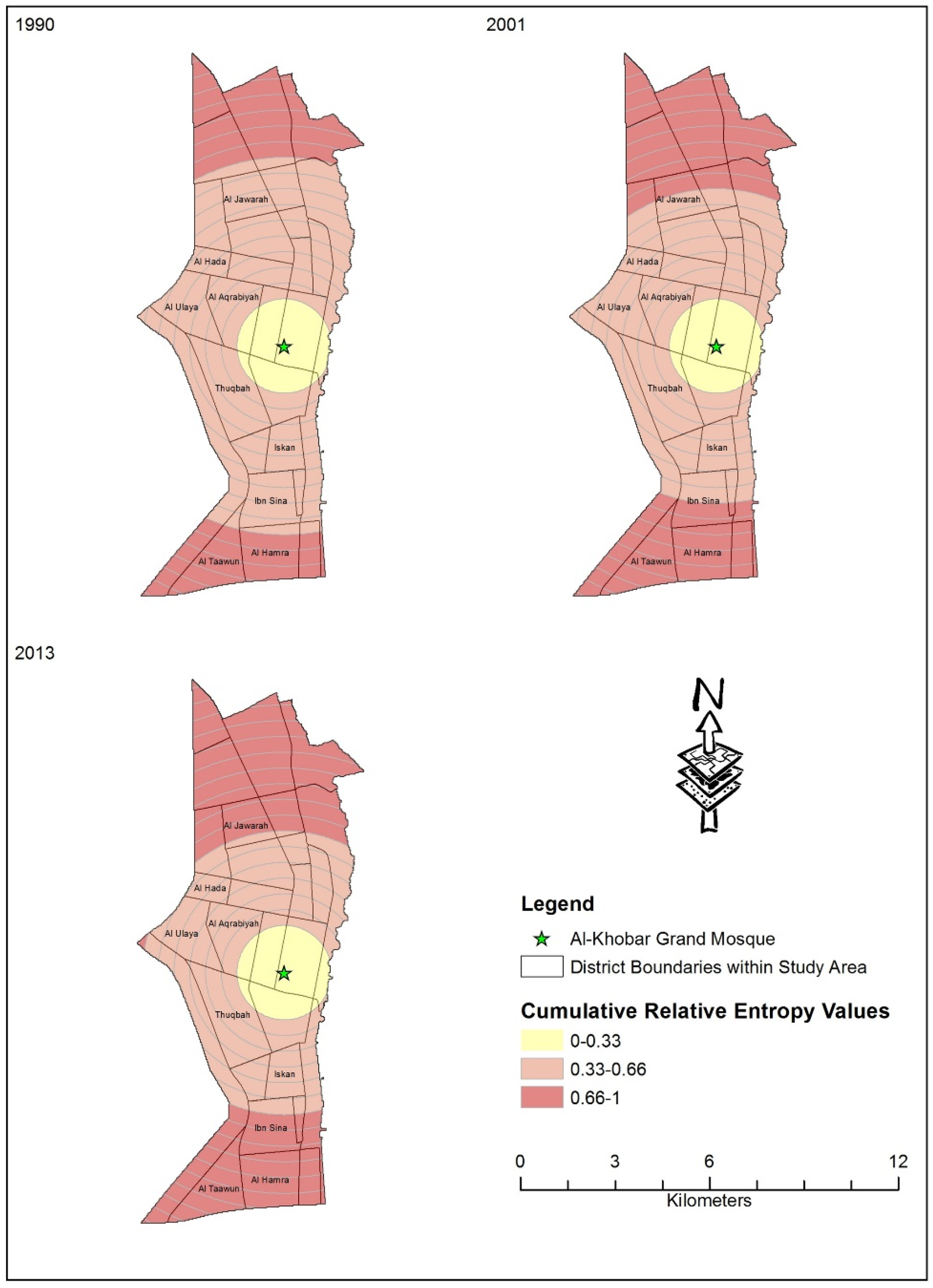1. Introduction
Urban encroachment and land use/land cover (hereafter LULC) changes around fast-growing cities in the developing world has drawn considerable attention from urban geographers and city and regional planners. Population growth in terms of increased population density is seen as the key factor directly inducing LULC changes and urban sprawl [
1,
2,
3]. Population growth demands construction of new residential, commercial, utility, and transport infrastructures. They also require conversion of forests, farmlands, and bare soils, causing LULC changes and urban sprawl. Urban sprawl has its threshold limits. At the lowest end of the spectrum, a city remains
uniform and vulnerable to change while rapid unplanned urban sprawl exceeding its maximum threshold limit creates
chaos and deteriorates the quality of city transportation and utility services. Hence an
organized and planned urban sprawl is essential to build a socially, economically, and environmentally sustainable society [
4,
5].
Population growth and urban sprawl indicate regional economic growth. However, human-induced deforestation and modification of natural landscape to construct buildings, water supplies, sewage, and transport networks exert various negative impacts on land and soil, biodiversity, vegetation, noise level, air and water qualities, and leads to an overall environmental degradation both inside a city and in its immediate vicinity [
6,
7,
8,
9,
10]. In addition, major construction works transform cities into impervious surfaces in which formation of heat islands contributes to local and regional climate changes and increases the occurrences of floods and other natural hazards [
11,
12,
13,
14,
15,
16]. Urban sprawl also increases land values, costs of living, economic disparities, and social stratification [
17,
18]. In order to reduce these negative impacts of urban sprawl and for planning a city’s future expansion, both local and regional urban planners, government officials, and policy makers need careful examination of its current LULC patterns and their spatio-temporal changes. They also need to assess the degree of urban sprawl that is occurring within the city with respect to population growth and economic development [
19,
20].
The study of LULC changes requires an analysis of a large amount of spatio-temporal data that were traditionally collected through ground-based field surveys. Over the past couple of decades, rapid improvements in remote sensing technologies, especially due to their affordable prices, large spatial coverages, repetitive observations, and efficient data-processing capabilities, has encouraged urban researchers and city planners to use remote sensing data to examine the spatio-temporal LULC changes and urban sprawl [
21,
22,
23,
24,
25,
26,
27,
28,
29]. The methods of identification of LULC changes using remote sensing data fall into pre-classification and post-classification categories [
30]. The pre-classification method processes a set of multi-temporal remote sensing images to create maps identifying areas of change or no-change in LULC without classifying the nature of changes [
11,
30,
31,
32,
33]. In contrast, the post-classification method compares two classified temporal remotely sensed images to produce maps that would depict changes within and between LULC classes over time. Therefore, it helps researchers and planners to detect the nature and direction of LULC changes and urban sprawl around cities [
30,
34,
35].
In the Kingdom of Saudi Arabia, Jeddah and Riyadh were the two major traditional cities besides the Islamic holy cities of Mecca and Medina. However, after the exploration of petroleum in the Eastern province of the kingdom in the late 1930s, the city of Dammam and its surrounding old fishing villages quickly grew into large cities during the 1940s and 1950s. The city of Al-Khobar (also known as Khobar or Al-Khubar), which was one of those old fishing villages adjacent to Dammam, was established in 1940. Currently, Dammam-Daharan-Khobar forms a major “triplet” city metropolis in the Eastern province that has experienced rapid population growth since 1990. Of the three cities, Dammam is the regional capital of the Eastern province, while Daharan houses the Saudi Arabian Oil Company (Saudi Aramco) and the King Fahd University of Petroleum and Minerals (KFUPM) with a regional airport and a Saudi Air Force Base. Both cities were already compact in the 1990s. Thus, any population growth and urban development in the area over the past two decades occurred in Al-Khobar. The total population of Khobar increased from 141,981 in 1990 to 456,559 in 2001 and to 679,988 in 2013 [
3,
36]. As the population grew, rapid construction of residential, economic, and transportation infrastructures required human modification of natural landscapes.
Numerous studies have examined the LULC changes in Saudi cities using remote sensing data. Al-Harbi examined the expansion of agricultural lands in Tabuk city in 2003 by calculating the Ratio Vegetation Index (RVI) using Landsat TM data [
37]. He conducted a follow-up study in 2010 by combining Landsat TM 5 and Spot 5 data to analyze agricultural change in the area [
38]. Alwashe and Bokhari [
39] used Landsat TM data to study vegetation changes in the city of Al-Madinah. Al-Gaadi, Samdani, and Patil used Landsat TM and ETM+ datasets and Normalized Difference Vegetation Index (NDVI) to detect land cover changes in the Dirab region in the western parts of Riyadh [
40]. In another study, authors in [
41] analyzed Landsat MSS, Landsat TM, and ASTER data to examine the urban expansion of Riyadh. For the city of Jeddah, authors in [
42] used a combination of aerial photos, SPOT satellite imageries, and Jeddah’s master plan to examine the patterns of urban expansion over the past four decades and their relationships with the development of urban transportation systems. The existing studies have assessed urban growth and changes mostly in the cities of central and western parts of the kingdom. Only recently, authors in [
3] analyzed GIS data and identified population growth as the key factor inducing urban sprawl in the northern part of Al-Khobar city during 1980−2005. However, this study has not examined the nature of LULC changes that occurred as a result of the population growth in the city. In addition, while the city’s population has grown even faster during the last decade and several noticeable changes occurred in the LULC patterns, there is an urgent need to examine the temporal LULC changes in this city. In order to formulate an environmentally sustainable land use plan for future expansion of this fast-growing city, it is extremely important to examine the dynamics of LULC changes, population growth, and the rate of urban sprawl that occurred in the city over the past two decades.
This present study examines the LULC changes and the nature of urban sprawl in the city of Al-Khobar using remotely sensed data for the years 1990, 2001, and 2013. It aims to classify LULC types in each year; detect changes that occurred in each LULC class; and measure the rate and direction of urban sprawl in response to population growth in the city over the past two decades.
Section 2 describes the study area, data, and methods used in the study while the results and the discussions of the findings are presented in
Section 3 and
Section 4. Finally, concluding remarks and directions for future research will be offered in
Section 5.
4. Discussions
By using the Landsat images for the years 1990, 2001 and 2013, this study identified water bodies, vegetation, built-up areas, and bare soils as four major LULC classes that have undergone significant changes in the city of Al-Khobar, thereby indicating rapid urban sprawl due to population growth and economic developments in Saudi Arabia’s Eastern province. Most notable among LULC changes was the conversion of bare soil into built-up area and manmade vegetation or the creation of green spaces. The city has received almost 539,000 people during the twenty-year period (1990–2013) owing to international migration of refugees and foreign troops during the Gulf Wars in 1990 and 2001, in addition to the massive influx of expatriate workers during the oil-based economic growth of the last decade [
81,
82,
83]. To accommodate the new settlers and provide them with various services, residential compounds and apartments, commercial centers, new residential hotels, restaurants, healthcare centers, and other social service facilities were also built during 1995
–2001 in the districts of Thuqbah, Al Aqrabiyah, Al Hizam Al-Akhdar, Qortoba Quarter, Al Rakah Al-Janubiyah, and along the corridor of the Dammam-Khobar highway.
With economic prosperity and increasing population during the past decade, Saudi residents began to invest in real estate by constructing new private residential and commercial housing and properties. Furthermore, the government’s land grant policy and the interest-free loan assisted middle class and low-income Saudis to obtain land and build personal residential houses and villas [
84]. From 2004 to 2010, almost 14,000 new residential housing units, including villas, apartments, and traditional houses were built in the Al Ulaya, Al Hada, Al Andalus, Al Rawabi, and Al-Bustan districts in the northern and western parts of the study area [
36]. At the same time, the construction of urban infrastructures, including roads, highways, schools, residential hotels, mosques, banks, shopping centers, and healthcare facilities, also contributed to the major urban sprawl in the city.
Findings of the study have several methodological and LULC planning implications. First, from the LULC classification methodology perspective, the study attempted to classify Landsat images using a supervised MLC method that yielded a lower accuracy level due to spectral confusions created by the overlapping of bare sandy desert soil with the similarly colored concrete building structures in the built-up areas. This finding is supported in the literature. Lower accuracy level in MLC was reported in other studies due to higher spectral confusion [
51], coarse spatial resolution [
85], and overlapping of mixed land uses and a high degree of sensitivity and complex spectral variations in land cover in the area [
48,
86]. Lower accuracy level of MLC results were also reported in a land use classification study of a similar desert environment in Israel [
86]. The study also found higher accuracy in LULC classifications using the unsupervised ISODATA algorithm in the desert environment [
86].
Second, the study has explored the rate, direction and patterns of urban sprawl in the selected city. Findings on urban sprawl suggest very low cumulative relative entropy, in turn indicating uniformity of high-density urban development in the old city center and its immediate neighboring areas; medium to high relative entropy in the organized newly developed areas in between the city center and the city periphery; and high relative entropy due to recent urban developments in the chaotic scattered city periphery. This finding supports the scheme of [
4] for classifying urban sprawl.
Third, from an urban planning perspective, the study results show that significant LULC and rapid urban sprawl occurred in the study area, thereby demanding careful planning for all subsequent construction. Over time, each of the uniform, organized, and chaotic zones of urban sprawl has grown in size, suggesting the growing compactness of urban development in the central city, rapid consumption of vacant lots in the organized zone, and major modification of natural landscape in the peripheral chaotic zone to build new houses and utility service facilities. Such modification of the natural landscape may have affected the city water drainage and flood control systems as evidenced in the recent occurrence of flash flooding in the city after winter rain. Rapid urban sprawl has deteriorated the transportation, water, sewage, and utility service facilities in the study area as evidenced by rush-hour traffic congestions in the central city, interrupted water supplies, and lack of hospital services in the chaotic city periphery.









